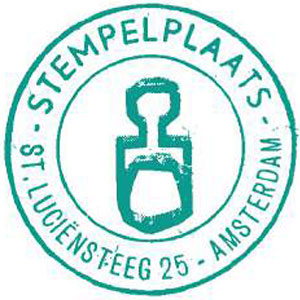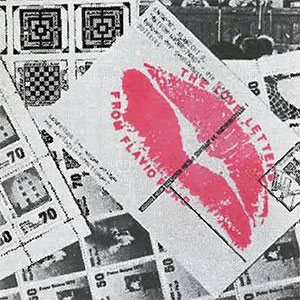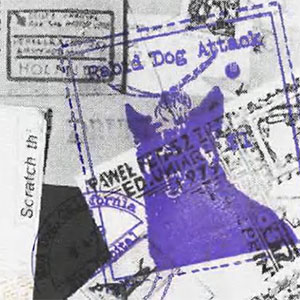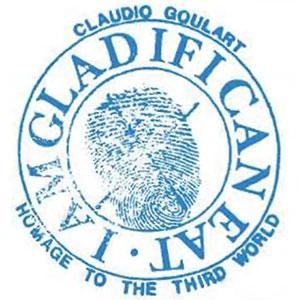Ulises Carrión: Personal worlds or cultural strategies?
Artists' postage stamps and cancellations stamps exhibition
Carrión, Ulises: Personal Worlds or Cultural Strategies? Introduction to the Artists’ Postage Stamps and Cancellation Stamps Exhibition, in: Artists’ Postage Stamps and Cancellation Stamps Exhibition, Stempelplaats, Amsterdam, 1979 (Ed. by: Ulises Carrión)

Rubberstamp of Stempelplaats (detail from the publication)
Introduction to the Artists' Postage Stamps and Cancellation Stamps Exhibition.
This Show includes works from some 150 artists living in or coming originally from some 25 countries. The cancellation stamps were all designed especially for this occasion by invited artists, and produced by the Posthumus Rubber Stamp Factory in Amsterdam. The postage stamps come, with few exceptions, from the Other Books and So Archive. They include either stamps that have been actually glued on postal pieces and often cancelled by the Post Office, or printed sheets with a varying number of stamps (see list of participants).
I'd like to make clear from the beginning that when I conceived of this show, my main concern was not to assemble a number of precious, curious miniatures. This clarification is necessary since most members of the public and the critics tend to miss the point when judging Mail-Art works and exhibitions - they usually look for plastic quality, for visual appeal. Since most Mail-Art pieces by nature don't lend themselves to such an approach, they tolerate Mail-Art as an ancillary activity of some good artists and a cover for crowds of bad ones. As I have said on other occasions, Mail-Art shifts the focus from what is traditionally called 'art' to the wider concept of 'culture.'
And this shift is what makes Mail-Art truly contemporary. In opposition to 'personal worlds,' Mail-Art emphasizes cultural strategies.
This radical shift gives birth to quite a number of theoretical and practical questions, the most evident of them being, Where does the border lie between an artist's work and the actual organization and distribution of the work? As it usually happens, this question can only be answered by the artists themselves rather than by theoreticians, historians, and bureaucrats. When an artist is busy choosing his starting point, defining the limits of his scope, he has the right to include the organization and distribution of his work as an element of the same work. And by doing so, he's creating a strategy that will become a constituent formal element of the final work.

Rubberstamp by Flavio Pons (detail from the publication)
Up to the present, no art critic has made a serious attempt to identify and des cribe the elements of works of this kind, how they affect each other, and the way they function as a whole, that is, as a finished art work. They apply instead concepts borrowed from other art practices that either cover too much or too little. The most striking of these inadequacies is related to the apparent plural authorship of a Mail-Art work. In a project like this one, containing around 150 pieces, am I to be considered the author of only that one showing my signature?
Am I innocent of the other 149? As I said above, this is not a collection of miniatures. All 150 pieces should rather be considered one element of a complex art work that involves much more than that which the public see hanging from the wall.
In Mail-Art, those unseen elements don't lay hidden in the depths of the artist's soul. They are conditions that the external world (physical and social) imposes on the artist and that he will structure in a particular way. The artist is thus also expressing his subjectivity, but only after having emerged from himself to act in the world. A Mail-Art project is an artist's attempt to organize, in a coherent way, a chaotic range of ideas, feelings, experiences, objects, but also machines, distances, postal regulations, time uncertainties, and,most strikingly, Mail-Art pieces from other artists. By incorporating these pieces as one element of his work, he's depriving them of their original identity. He's giving them instead a role to play among other equally important elements of his own personal world.
Size, colour, dimension, number, reproduction technique, number of items, number of copies, placement, material, actual use, perforation, repetition, outline, image, combination, cut, alteration, context, sequence, support, completeness, utility, fragmentation, rhythm, imitation, likeness, origin, these are some of the elements to be noticed in each individual item of this show. But the show as a whole offers a greater number and complexity of significant elements. Considering the show as a hole, every piece included in the show has the same value, that is, the same meaning.
People cannot be stopped from exerting their own capacity for choice, but it's possible for this capacity to be applied in the wrong direction. In the case of a collection of postage and cancellation stamps the public would tend to admire those that are attractively designed, professionally produced, preferably multicoloured. Such a preference would reveal a point of view not applicable in a show of this kind. It's as if you'd like an abstract painting because it reminds you of an object! A more coherent attitude would be paying attention to the tension or lack of tension between form and function. For instance, how far one can go in creating postage stamps and cancellation stamps that don't look like real ones but have effectively functioned as real ones? Or, in the opposite direction, works that from a formal point of view can be identified as postage stamps or cancellation stamps but aren't intended for functioning as real ones?
This analysis, however interesting as it may be, possesses only a partial, provisional validity, since it considers no more than fragments artificially cut out from the whole – the Mail-Art project. How are we to approach this?
A Mail-Art project like the present one is the outcome of a process consisting of 3 main phases: One artist's conception and announcement of the project; the answers from a number of artists to the invitation to participate; and the presentation of the answers to the public in the form of a show. The invitation has no value in itself, it only offers the opportunity for something that hasn't yet happened. Yet it is a necessary element for the art-piece to occur effectively. The answers validate the existence of the invitation. They don't have any value in themselves, but only as answers to the original invitation. Invitation and answers exist in a dialectical interdependence upon each other. The answers embody the forces triggered by the invitation, thereby revealing beauty. The beauty of each particular answer lies in its being an answer. The most perfectly the response fits the request, the more beauty it possesses.
Why is the artist asking for answers from other individuals instead of giving himself multiple answers? He has indee renounced the possibility unique answer. The necessity of giving multiple answers is then revealed, concretised by the plurality of sources. From this point of view, a Mail-Art project is never closed. Every human being, even those who will never hear the question, can provide an infinite number of possible answers. And here intervenes perhaps the most crucial element in a Mail-Art project - showing the answers to an audience. The artist should convince the audience that they are looking at him, that every piece in the show, that all these apparently unconnected pieces coming from various sources and with various purposes, are a true reflection of himself. They are his personal world, nothing more and nothing less! Only, he's letting his world gain a social reality by making a show out of it, that is, a cultural event. He's thereby creating models for a cultural strategy.

Rubberstamp by Rabid Dog Attack (detail from the publication)
If this is so, it looks as if I have arrived at an important conclusion without even mentioning the Post Office, and this is quite strange for a text dealing with Mail-Art. Or, isn't it? The Post Office provides the artist with a distribution network but it doesn't define the work. The Post Office is not an essential element of the work and it could be replaced by other transportation systems. The Post Office catches the attention of artists and the public because of its strangeness when compared with other media. It is in fact the most complex, the least traditional of all the media that artists are using nowadays. At first sight, compared to telephones or televisions, the Postal System seems rather slow, unsafe, complicated, awkward, inefficicient, uncontrollable. But these imperfections leave space for play, for invention, for surprise. those qualities that Mail-artists have been exploiting for quite a number of years now. And this is natural. When the use of new media (radio, TV) places an old medium like the PTT in a disadvantageous position, then the latter can afford to be used for the sake of invention and beauty. In the Renaissance, the appearing of painting as an activity with purely artistic intentions, as compared with the didactic function it had had before, was made possible by the invention of the printed books, that became then a more adequate way of disseminating ideas. In our time, the invention and spreading of multimedia communication allows for the purely artistic use of "monomedia" like books, postcards, letters, etc.
This in turn triggers process of analyses and renovation of the used media, that could not be foreseen or allowed when they were being used for purely practical purposes. In the case of MailArt, such a process hasn't yet finished and we cannot foresee which direction it will take next, which aspect of the process will attract next the attention of the artists. But we can identify some of the supportive or formal elements that have already undergone a deep transformation in the hands of Mail-artists, like envelopes, letters, postcards, rubber-stamps, cancellation stamps, postage stamps. The present show offers quite a number of alternatives for the last 2 mentioned categories. A detailed study of each particular work would be most helpful, on the condition that it be done within an ideological context which proves to be suitable for Mail-Art projects.
Ulises Carrión
Other Books and So Archive
Amsterdam
1979.

Rubberstamp by Claudio Goulart (detail from the publication)
